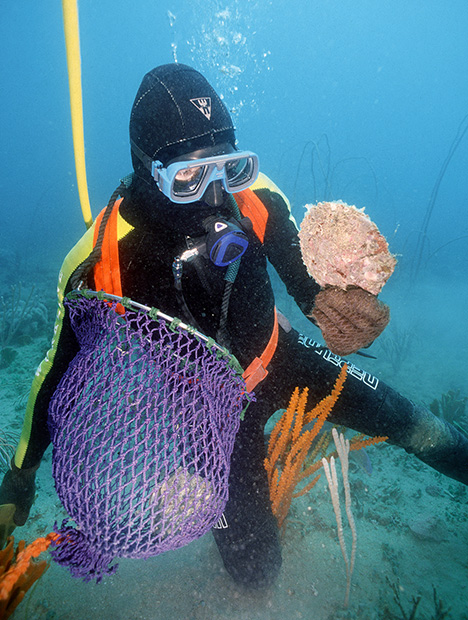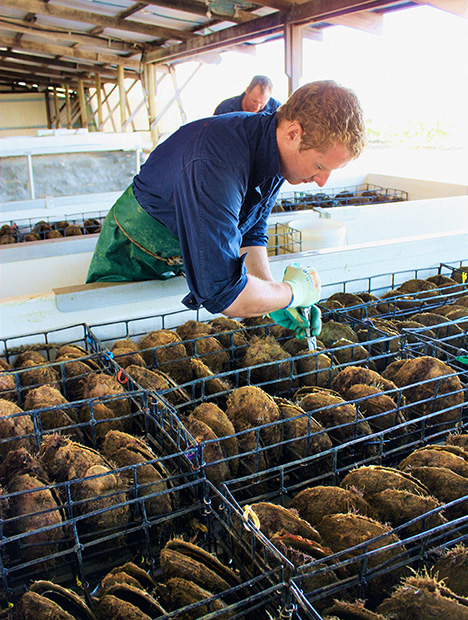An Environmental, Social, and Governance Assessment of Marine Pearl Farming

Farming pearl oysters is an important economic activity that, when done sustainably, can also provide valuable environmental and social benefits. To gain an evidence-based understanding of the sustainability challenges and opportunities facing marine pearl farming and their intersection with environmental, social, and corporate governance (ESG), The Nature Conservancy (TNC), a U.S.-based nonprofit, conducted an ESG assessment of an Australian pearl farm. This pilot project was intended to guide the development of a sector-wide ESG and sustainability assessment framework. The project was supported and funded by GIA as part of its global effort focused on education and the promotion of responsible practices.
Pearl oysters filter water at rates that are often higher than those reported for other oyster species. This filtration process contributes to waste treatment through the uptake of not only nutrients (nitrogen and phosphorus) but also heavy metals (S. Gifford et al., “Quantification of in situ nutrient and heavy metal remediation by a small pearl oyster (Pinctada imbricata) farm at Port Stephens, Australia,” Marine Pollution Bulletin, Vol. 50, No. 4, pp. 417–422; L.T. Barrett et al., “Sustainable growth of non-fed aquaculture can generate valuable ecosystem benefits,” Ecosystem Services, Vol. 53, 2022, article no. 101396). Pearl oysters are hung in baskets suspended from long lines, and these structures in which they are farmed provide habitat for a variety of fish and invertebrates (S.J. Theuerkauf et al., “Habitat value of bivalve shellfish and seaweed aquaculture for fish and invertebrates: Pathways, synthesis and next steps,” Reviews in Aquaculture, Vol. 14, No. 1, 2022, pp. 54–72). If the negative impacts of pearl farming can be mitigated and effective sustainability strategies implemented through waste reduction, recovery and reuse, disease mitigation, and avoidance of overstocking, pearl farming could significantly benefit regional economies and local marine environments.
TNC’s 2019 report titled Towards a Blue Revolution provided comprehensive guidance for evaluating critical aquaculture systems. Since the report’s publication, TNC has built a science-based tool to assess industry and company operations. This tool takes into account factors related to the natural environment as well as the inherent and unique characteristics of a sector or company’s operations. The tool has been designed to consider environmental data and the health of local ecosystems, enabling the identification of potential environmental benefits via restorative aquaculture, which has the potential to generate a net positive ecosystem outcome. This approach sets it apart from other sustainability assessment frameworks, risk assessments, and life cycle assessment methodologies.


Between February and May 2023, the assessment was conducted on Cygnet Bay Pearl Farm (CBPF; see figures 1–3), a company that produces pearls from Pinctada maxima north of Broome, Western Australia, using both wild capture and hatchery operations. CBPF is an operation of Pearls of Australia (PoA). Using the TNC framework, a number of overarching factors were assessed:
- Company capacity, ethics, and management measures
- Impacts on wild stocks from source of stock, hatchery escapes/interbreeding, and macrofauna interactions
- Reliance on added feed and chemicals
- Habitat impacts
- Water column effects (e.g., temperature, salinity, light penetration, and chemical characteristics of seawater at different depths)
- Disease
- Use of resources: fresh water, land, and energy
The assessment showed that CBPF meets or exceeds all essential requirements within the ESG framework, including the company capacity, ethics, and management metrics. The company has no compliance issues associated with sustainability metrics, and an internal management team oversees sustainability topics and implementation. CBPF adheres to the Pearling Environmental Code of Conduct, developed by Australia’s Pearl Producers Association in 2002 and updated in 2007. The farm has Marine Stewardship Council certification, meeting independent, third-party ecological sustainability standards. It operates within a country that has an effective governance, legal, and enforcement system in place to manage the industry into the future.
Regarding the social component of ESG, CBPF forms part of the Banararr Steering Committee (BSC) of the Bardi people, the traditional owners of the area. The BSC’s role is to establish a positive relationship between CBPF and the Bardi traditional owners. Any amendment, use, or development of the area is discussed by the BSC together with relevant topics affecting the community at large, including school, transport, and fishing. Dedicated cultural heritage tours managed by Bardi people form part of the ecotourism offered at Cygnet Bay Pearl Farm. CBPF is active in research, housing the Kimberley Marine Research Station, and parent company PoA currently partners with the Marine Bioproducts Cooperative Research Centre. This research focuses on better understanding the implications and potential positive effects on fish and invertebrates that grow naturally on PoA farms.
CBPF could already be providing environmental benefits to the surrounding area through restorative aquaculture practices. Based on a general understanding of ecosystem services associated with oyster aquaculture, CBPF does meet the criteria for restorative outcomes, such as increased cycling of water and nutrients and providing habitat to other species. However, the extent to which these ecosystem services positively impact broader environmental outcomes remains unknown, in part because of the limited understanding of anthropogenic effects on water quality and habitat loss in the area.
Overall, the assessment provided an effective means to evaluate CBPF for its management and approach to ESG, the extent to which cultural communities are considered, the company’s engagement with voluntary certification and codes of practices, and its awareness of key environmental risks and negative impacts as well as positive impacts.
At the same time, additional needs for TNC’s ESG Assessment Framework have been identified. Brood stock sourcing and handling, biosecurity, and genetic risks are all areas that require additional research. One hundred percent utilization of the oysters farmed should be an explicit goal and assessment factor. The assessment should also consider the legacy effects of aquaculture equipment (e.g., recovery, reuse, and recycling), as well as the origin and species status of shells utilized to manufacture nuclei. Once these considerations are addressed, the TNC’s ESG Assessment Framework should provide an effective sector-wide approach.
.jpg)


